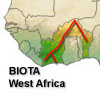 



Weather data
A large number of automatic weather stations has been implemented in the frame of the BIOTA AFRICA project by the Namibian National Botanical Research Institute (NBRI) and the Group "Biodiversity, Evolution and Ecology" (BEE) of the University of Hamburg. The website offers hourly updates of data and graphs of a large number of weather parameters.

|
 BIOTA West Africa - Workpackage - CT2-T1-WP2b
BIOTA West Africa - Workpackage - CT2-T1-WP2b
Core Topic (CT) |
Land use changes: agriculture and restoration |
Topic (T) |
Land use change related to cash crops |
Title |
 Socio-economic causes and consequences of cotton and cacao cultivation - The socio-economics of cotton production in Benin and Burkina Faso
Socio-economic causes and consequences of cotton and cacao cultivation - The socio-economics of cotton production in Benin and Burkina Faso
|
Project leader(s) |
Dr. Nassirou Bako-Arifari
Dr. Nikolaus Schareika
Prof. Dr. Michael Kirk
Dr. Pamphile Degla
|
Project description |
Socio-economic research on cotton in West and Central Africa (WCA) has been developed along different lines and offers only a limited background and patchy entry points for further research.
The agro-economic component of this workpackage therefore aims at the following:
- To identify at a farm/household level the gender-specific importance of cotton production for the performance of the smallholder enterprise resulting from changes of agricultural policies with regard to factor input (including pesticides, Bt cotton or IPM), revenues from cropping, contribution of cotton to farm/household income, and investment patterns;
- To identify the supply response of small scale cotton producers to changes in agricultural price policies, the impact on factor use, profitability, farming system development and expected pathways on future intensification, diversification or extensification which, in turn, directly impacts biodiversity change in cropping areas;
- To assess smallholders’ knowledge on ecological damage caused by cotton production, resulting cause-effect-chains and options to reduce the trade-off;
- To integrate relevant literature results from existing bio-economic modelling approaches on cash crop farming and resource degradation;
- To assess the responsiveness of smallholders on cotton-related technical innovations in the recent past, such as improved seeds from conventional breeding, fertilizer and pesticide application (and in case of availability: Bt cotton trials), animal traction but as well as institutional innovations such as modified rotational and fallow systems, participatory credit schemes, producer associations, contract farming or vertical integration initiated by national cotton agencies;
- To analyze on parallel terms – together with social scientists – at a macro-level the potential impact of other policy instruments (ecologically oriented legal and price (dis-)incentives), as well as regulations on factor and product markets or on competition on the decision making of cotton producers towards biodiversity protection.
|
|
|






 Go to the WeatherNet
Go to the WeatherNet BIOTA West Africa - Workpackage - CT2-T1-WP2b
BIOTA West Africa - Workpackage - CT2-T1-WP2b Socio-economic causes and consequences of cotton and cacao cultivation - The socio-economics of cotton production in Benin and Burkina Faso
Socio-economic causes and consequences of cotton and cacao cultivation - The socio-economics of cotton production in Benin and Burkina Faso